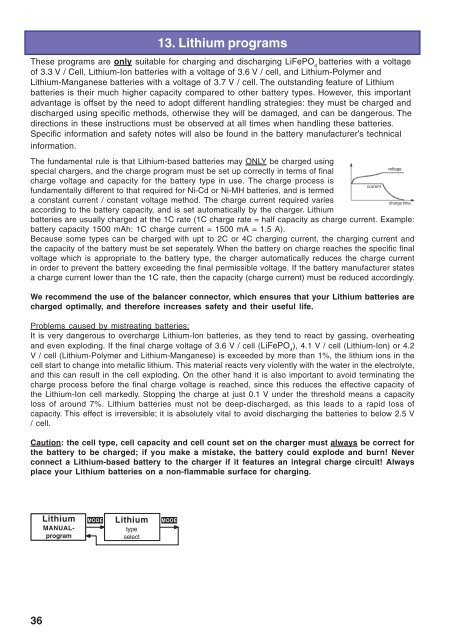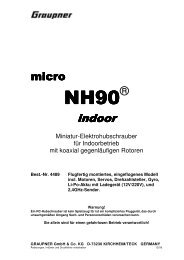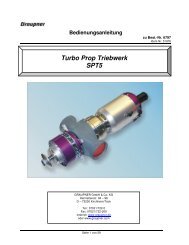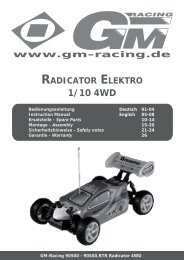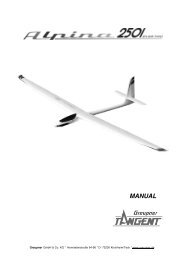ULTRAMAT 14 plus - Graupner
ULTRAMAT 14 plus - Graupner
ULTRAMAT 14 plus - Graupner
Create successful ePaper yourself
Turn your PDF publications into a flip-book with our unique Google optimized e-Paper software.
The fundamental rule is that Lithium-based batteries may ONLY be charged using<br />
voltage<br />
special chargers, and the charge program must be set up correctly in terms of final<br />
charge voltage and capacity for the battery type in use. The charge process is<br />
current<br />
fundamentally different to that required for Ni-Cd or Ni-MH batteries, and is termed<br />
a constant current / constant voltage method. The charge current required varies<br />
charge time<br />
according to the battery capacity, and is set automatically by the charger. Lithium<br />
batteries are usually charged at the 1C rate (1C charge rate = half capacity as charge current. Example:<br />
battery capacity 1500 mAh: 1C charge current = 1500 mA = 1.5 A).<br />
Because some types can be charged with upt to 2C or 4C charging current, the charging current and<br />
the capacity of the battery must be set seperately. When the battery on charge reaches the specific final<br />
voltage which is appropriate to the battery type, the charger automatically reduces the charge current<br />
in order to prevent the battery exceeding the final permissible voltage. If the battery manufacturer states<br />
a charge current lower than the 1C rate, then the capacity (charge current) must be reduced accordingly.<br />
We recommend the use of the balancer connector, which ensures that your Lithium batteries are<br />
charged optimally, and therefore increases safety and their useful life.<br />
Problems caused by mistreating batteries:<br />
It is very dangerous to overcharge Lithium-Ion batteries, as they tend to react by gassing, overheating<br />
and even exploding. If the final charge voltage of 3.6 V / cell (LiFePO 4 ), 4.1 V / cell (Lithium-Ion) or 4.2<br />
V / cell (Lithium-Polymer and Lithium-Manganese) is exceeded by more than 1%, the lithium ions in the<br />
cell start to change into metallic lithium. This material reacts very violently with the water in the electrolyte,<br />
and this can result in the cell exploding. On the other hand it is also important to avoid terminating the<br />
charge process before the final charge voltage is reached, since this reduces the effective capacity of<br />
the Lithium-Ion cell markedly. Stopping the charge at just 0.1 V under the threshold means a capacity<br />
loss of around 7%. Lithium batteries must not be deep-discharged, as this leads to a rapid loss of<br />
capacity. This effect is irreversible; it is absolutely vital to avoid discharging the batteries to below 2.5 V<br />
/ cell.<br />
Caution: the cell type, cell capacity and cell count set on the charger must always be correct for<br />
the battery to be charged; if you make a mistake, the battery could explode and burn! Never<br />
connect a Lithium-based battery to the charger if it features an integral charge circuit! Always<br />
place your Lithium batteries on a non-flammable surface for charging.<br />
36<br />
13. Lithium programs<br />
These programs are only suitable for charging and discharging LiFePO 4 batteries with a voltage<br />
of 3.3 V / Cell, Lithium-Ion batteries with a voltage of 3.6 V / cell, and Lithium-Polymer and<br />
Lithium-Manganese batteries with a voltage of 3.7 V / cell. The outstanding feature of Lithium<br />
batteries is their much higher capacity compared to other battery types. However, this important<br />
advantage is offset by the need to adopt different handling strategies: they must be charged and<br />
discharged using specific methods, otherwise they will be damaged, and can be dangerous. The<br />
directions in these instructions must be observed at all times when handling these batteries.<br />
Specific information and safety notes will also be found in the battery manufacturer’s technical<br />
information.<br />
Lithium<br />
MANUALprogram<br />
MODE Lithium<br />
type<br />
select<br />
MODE


